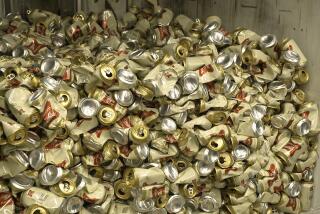Sam Adams backtracks on no-can pledge -- and thatâs a good thing
Boston Beer Co., one of the oldest -- and largest -- craft beer brands in America, announced this week that it would begin canning its signature Samuel Adams Boston Lager. The amber lager will be available in specially designed âSam Cansâ this summer, and the move is a change in direction for the craft giant that declared in 2005âs âCraft Beer Bill of Rightsâ that âBeer shall be offered in bottles, not cans, so that no brew is jeopardized with the taste of metal.â
Craft beer in cans is nothing new. Coloradoâs Oskar Blues Brewery was the first craft brewery to can itsbrews, more than 10 years ago, and the company fought an uphill battle against the idea that only insipid lagers come in cans. Beer drinkers may have been slow to accept quality beer in cans, but today there are dozens of breweries -- including L.A.âs own Golden Road Brewing -- that package their brews in cans.
Even with canned craft beer becoming more commonplace, there are still many myths and misconceptions about the process and purpose of canned beer. Jim Kochâs fear of cans imparting a metallic taste to the beer isnât an issue because beverage cans are lined with a plastic epoxy to prevent this. Though, this lining does contain the possibly dangerous chemical BPA, and the Canadian government confirmed that BPA will leech into the beer from this lining (PDF link).
Fears of chemical contamination aside, beer cans do a better job at protecting beer from two of its biggest enemies: oxygen and light. Beer packaged in cans wonât ever become light-struck and skunky, and the reduced exposure to oxygen can prolong its shelf-life. Proponents of canned beers often cite lower shipping costs and easier recycling of canned beers compared to bottles (though the environmental impact of aluminum mining may offset these benefits). For every âproâ for canning beer there is another âconâ to balance things out.
There is no denying that cans can go some places -- poolside, the golf course, camping -- where bottles are not appropriate, but neither package is truly superior to the other. Like so many other things in the craft beer world, the can versus bottle debate all comes down to personal preference. Drink the beer you want to drink, and buy it in the packaging that works for you. Itâs most important to remember that itâs the beer on the inside, and not the packaging, that truly matters, and that, whether the beer was from a can or a bottle, youâll get the biggest impact of aroma and flavor from craft beer when you pour it into a glass.
ALSO:
More to Read
Eat your way across L.A.
Get our weekly Tasting Notes newsletter for reviews, news and more.
You may occasionally receive promotional content from the Los Angeles Times.










